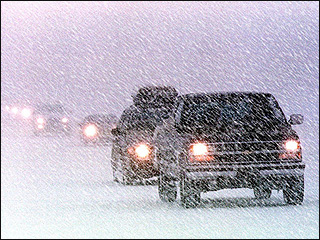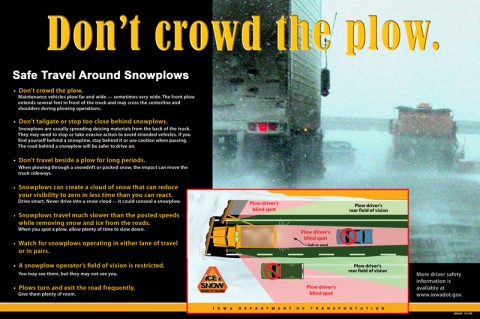Reduce your speed!
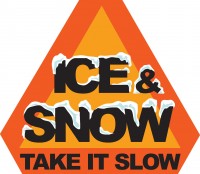 Nashville – The Tennessee Department of Transportation would like to offer drivers these tips to follow when dealing with winter weather. Remember Ice and Snow: Take It Slow
Nashville – The Tennessee Department of Transportation would like to offer drivers these tips to follow when dealing with winter weather. Remember Ice and Snow: Take It Slow
When it snows, use your head not your feet. Slow down for wet, snowy, or icy conditions; when visibility is poor; or when conditions are changing or unpredictable; no matter what type of vehicle you drive. Even an SUV with four-wheel drive may not be able to stop any faster, or maintain control any better, once you lose traction.
Slow down when approaching intersections, off-ramps, bridges or shady spots. These are all candidates for developing black ice — a thin coating of clear ice that can form on the pavement surface that may be difficult to see.
Avoid excessive actions while steering, braking or accelerating to lessen the chances of losing control of the vehicle.
Space out! Leave plenty of room between your vehicle and others. It takes more time and distance to stop your vehicle in adverse weather conditions, so use your brakes carefully. Brake early, brake slowly, brake correctly, and never slam on the brakes.
No Cruising! Avoid using cruise control in winter driving conditions. You need to be in control of your speed based on road conditions — don’t let the cruise control make a bad decision for you.
Remember: Winter conditions call for different driving tactics. Ice and snow, take it slow—slower speed, slower acceleration, slower steering, and slower braking.
Safe Travel Around Snow Plows
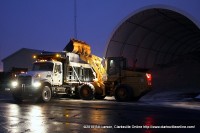
Don’t crowd the plow. Snowplows plow far and wide—sometimes very wide. The front plow extends several feet in front of the truck and may cross the centerline and shoulders during plowing operations. Plows also turn and exit the road frequently.
Don’t tailgate or stop too close behind snowplows. Snowplows are usually spreading deicing materials from the back of the truck and those materials can damage vehicle paint. Plows also may need to stop or take evasive action to avoid stranded vehicles. If you find yourself behind a snowplow, stay behind it or use caution when passing. The road behind a snowplow will be safer to drive on.
On multiple lane roads, watch for snowplows operating in either lane. Snowplows travel much slower than the posted speeds while removing snow and ice from the roads. When you spot a plow, allow plenty of time to slow down.
A snowplow operator’s field of vision is restricted. You may see them but they may not see you.
Be Prepared!
 Before leaving home, find out about the driving conditions by calling 511 from any land line or cellular phone or visiting www.tn511.com. Safe drivers know the weather, and they know their limits. If the weather is bad, remember, ice and snow, take it slow, or just don’t go.
Before leaving home, find out about the driving conditions by calling 511 from any land line or cellular phone or visiting www.tn511.com. Safe drivers know the weather, and they know their limits. If the weather is bad, remember, ice and snow, take it slow, or just don’t go.
Before venturing out onto snowy roadways, make sure you’ve cleared the snow off all of your vehicle’s windows and lights, including brake lights and turn signals. Make sure you can see and be seen. Always buckle up, and remember, when driving in ice and snow, take it slow.
Give yourself extra time to reach your destination safely. It’s not worth putting yourself and others in a dangerous situation, just to be on time.
Winter conditions can be taxing on your vehicle. Check your vehicle’s tires, brakes, fluids, wiper blades, lights, belts, and hoses to make sure they‘re in good condition before the start of the winter season. A breakdown is bad on a good day, and can be dangerous on a bad-weather day.
Driving Maneuvers
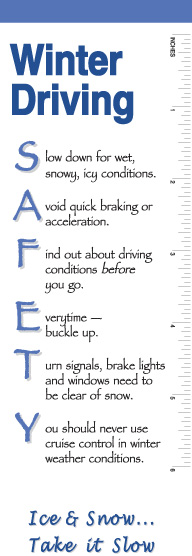 Stopping on snow and ice without skidding requires extra time and distance. If you have anti-lock brakes, press the pedal down firmly and hold it. If you don’t have anti-lock brakes, gently pump the pedal. Either way, give yourself plenty of room to stop.
Stopping on snow and ice without skidding requires extra time and distance. If you have anti-lock brakes, press the pedal down firmly and hold it. If you don’t have anti-lock brakes, gently pump the pedal. Either way, give yourself plenty of room to stop.
When you’re driving on snow, accelerate gradually.
When you’re driving on snow, ice or wet roads, avoid abrupt steering maneuvers.
When you’re driving on snow, ice or wet roads, merge slowly, since sudden movements can cause your vehicle to slide.
When driving in adverse road conditions, look farther ahead in traffic than you normally do. Actions by other vehicles will alert you to problems more quickly, and give you that split-second of extra time to react safely.

